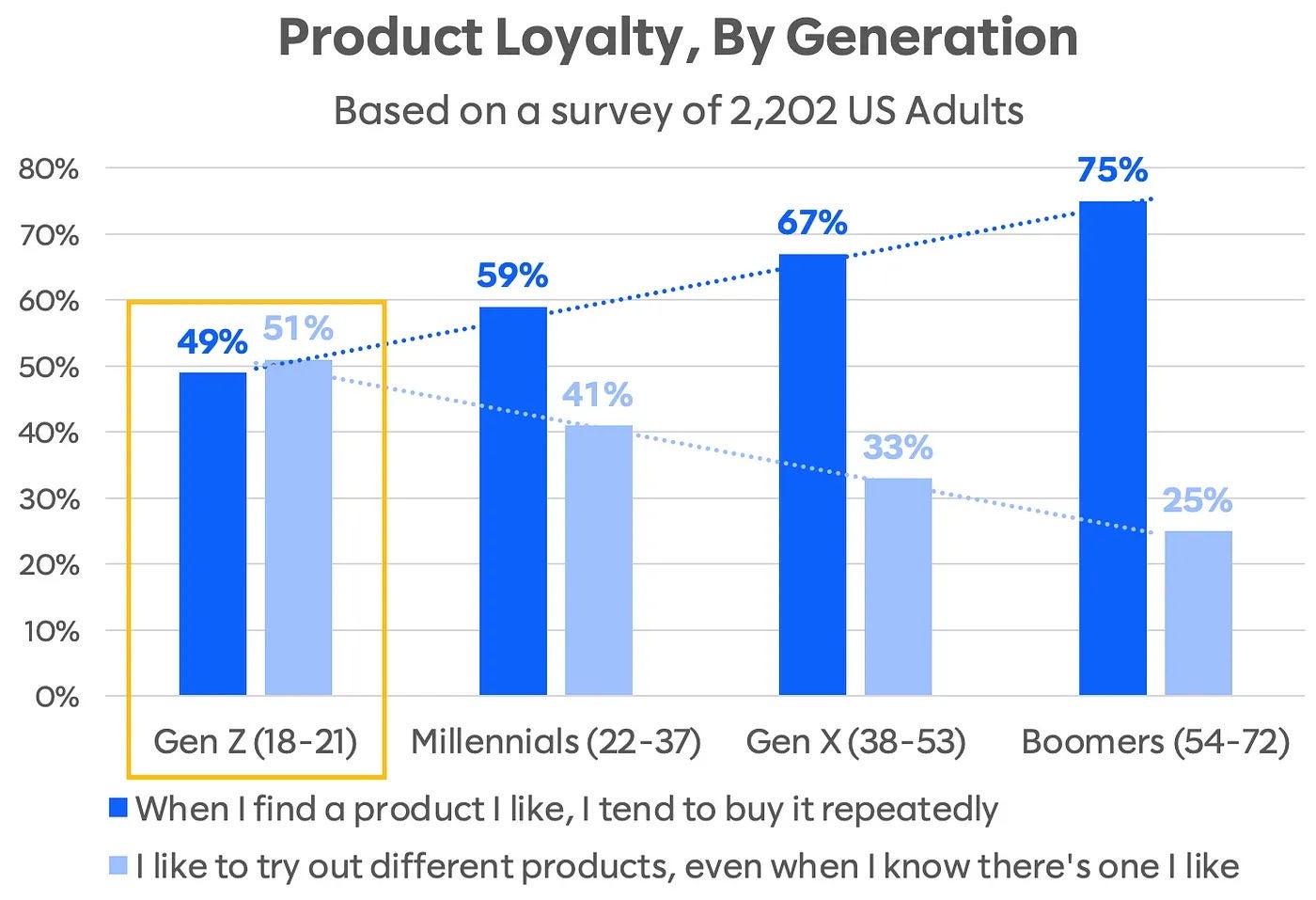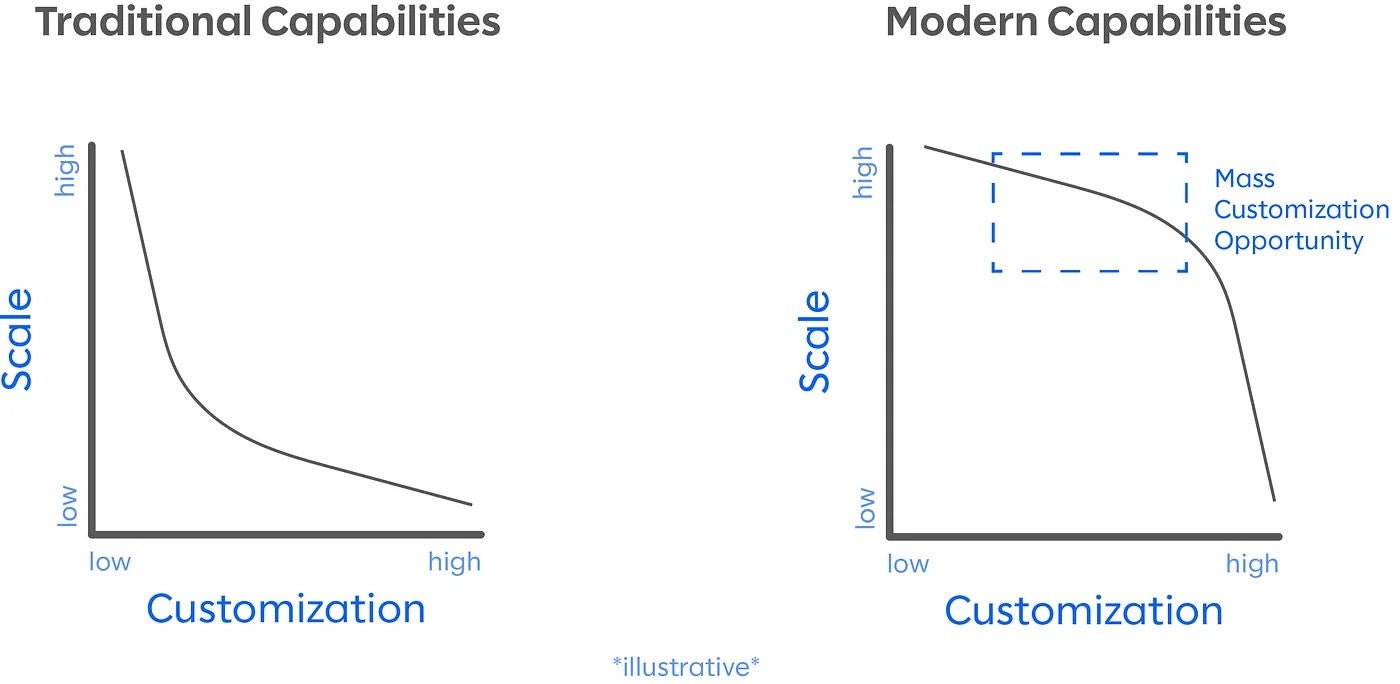Rethinking customer value propositions with mass customization
 How to charge more, ship slower, and maximize customer satisfaction
How to charge more, ship slower, and maximize customer satisfaction
Product price and delivery speed are two of the most heavily marketed value propositions, with intense marketplace competition and extensive venture funding cutting both prices and time to delivery. However, these factors are becoming consumer expectations instead of differentiators. Plus, in many cases, both cost and delivery speed can only incrementally improve; same-hour delivery and selling at a loss to gain customer loyalty are both the reality in numerous markets. On top of that, advancing both value propositions are costs to the organization.
Most importantly, lower prices and faster delivery speeds increase the transactional nature of a purchase. If a consumer interprets one brand as the cheapest or fastest, then finds another cheaper or faster brand—assuming all other factors are constant—changing brands is the rational decision.
As seen in the chart below, decreasing customer loyalty is a generational trend that inverted with Gen Z for the first time since the 1940s. On average, young adults today prefer trying different products as opposed to repeatedly buying products they know they like, which is a major challenge for building brand loyalty and increasing a customer’s lifetime value.

The rise of app-based customer loyalty programs is one solution to increase Gen Z’s lifetime value for a single brand, but the rewards for loyalty normally consist of lower prices and faster delivery—the very factors leading to transactional brand relationships.
Since price and delivery speed as differentiators are expensive for companies and increasingly less distinctive for consumers, many astute organizations are turning to mass customization. Mass customization increases revenue, decreases consumer shipping expectations, and increases brand evangelism. Both global organizations and small businesses alike are leveraging mass customization to stand out from the competition and delight their customers, and you can as well.
The case for optimizing with mass customization
Traditional customization of the industrial revolution suffered from an inverse relationship between level of customization and level of scale. However, with the progression of manufacturing technology, the tradeoff between scale and customization has become significantly less pronounced, and—as a result—mass customization is possible.

Note that personalizing a consumer shopping experience based on their data—such as recommended items based on past purchases in a marketing email or on a website’s checkout page—is a separate topic from allowing consumers to customize their products. That said, content personalization is a complementary strategy to help consumers understand the best customizations for them.
Want more ways to unlock hidden value in your organization? Learn how to empower your teams to drive efficiency and focus spend on what matters most in turbulent times. Get the guide.
Cultural factors influencing mass customization
Two main forces — sociological and manufacturing trends — have influenced the cultural optimization for receptivity to mass customization.
1. Sociological trends
America, the world’s biggest consumer, is historically one of the most culturally individualistic societies. However, research done across 78 countries spanning 51 years found the world has grown 12% more individualistic as well. In line with this global transition from communal to individualistic societies, researchers have predicted since the early 2000’s a shift from consumers as passive buyers of generic goods to active co-creators of unique items reflecting their independent personality.
The future of branding is less about an individual embodying a company’s brand and more about a company helping an individual represent their own brand.
2. Manufacturing trends
Given recent advances in mechatronics engineering (a.k.a., programming those fancy robotic arms in manufacturing plants), it’s never been easier to connect the consumer directly to the production of their product. Instead of warehouses full of human laborers or simple machines only capable of conducting a single task repetitively, flexible manufacturing systems (FMSs) today can respond to unique production variation requests, allowing consumers to directly submit through software automation from online purchases. Essentially, technology has made it easier than ever to mass customize at scale.
Benefits of mass customization
The benefits of mass customization include:
- Increased customer revenue — 20% more across 8 industries according to 2019 research
- Decreased shipping time pressure — 48% of consumers are willing to wait longer for a customized product over one that isn’t, and only 24% expect same delivery times
- Increased customer satisfaction — Customer experience psychologist Liraz Margalit encapsulates the value derived from her research on mass customization in two phrases:
- “I built it, therefore I own it.” (The opportunity to take part in a process and influence the end result promotes emotional attachment that leads to psychological ownership.)
- “I own it, therefore it’s superb.” (When people imbue products with their own labor, their efforts increase the value of the product.)
One of the primary benefits of mass customization is the customer experience of co-creating something for them as opposed to the transaction they complete when purchasing something for people like them.
Are there costs associated with mass customization? Yes. Mass customization adds complexities to the production process and supply chain, confusing consumers if not presented in an intuitive manner. However, culture is shifting toward co-creation, and brands across industries are starting to recognize this value by incorporating mass customization into their offerings.
Mass customization implementation opportunities
There are three business functions any industry can focus on to enable mass customization. While the following examples are a source of inspiration as opposed to a checklist, there is an opportunity across sales, technology, and operations to give customers more control of their purchase while mitigating the impact to scale.
Sales
1. Offer showroom locations with no inventory — just components for custom product creation.
Brands like Indochino and Tesla take this approach. Research shows being able to touch a product increases psychological ownership.
2. Engage customers with their name.
Coca-Cola turned around a decade long sales decline by adding the 100 most popular names to their cans. Ritz Carlton relays customer names from valet to the check-in counter so customers are welcomed by name with their room keys when they approach the counter.
3. Customize products to the geography in which they’re offered.
Starbucks offers coffee mugs with the skyline of the city the store is in, perfect for proud locals and tourist collectors. Discontinued city’s mugs are sold on secondary markets for over $10,000.
4. Mass produce base products and a variety of accessories that customers can easily mix and match.
Jeep does this with roll bars, headlights, and more, while Crocs does this with “jibbitz,” allowing them to upsell components to customize base products.
Technology
1. Optimize fulfillment and supply chain tech-stack integration.
Mass customization’s end-product diversity creates increased complexity for production and supply chain management. Platforms like Snowflake break down data silos to automate consumer fulfillment smarter.
2. Manage customer data to track preferences and leverage for future custom experiences.
Wayfair tracks customers’ product drop-off preferences (such as “garage” v.s. “front door”) to provide tailored delivery experiences.
3. Connect customer purchases directly to specialized producers.
Etsy has done this with a marketplace software connecting customers with a plethora of individual creators who can each offer highly customized products.
4. Leverage augmented reality (AR) and virtual reality (VR) for consumers to experience customizations before purchasing them.
Sephora offers an AR app experience for consumers to virtually ‘try-on’ makeup products to match their unique complexion.
Operations
1. Utilize delayed differentiation, saving customizations for the final steps of the production process.
Apple consumers can add a custom engraving to their product after the product is produced.
2. Capture and send progress images during production to emphasize customer co-creation.
Ferrari and Porsche have cameras set up in their production lines to send customers progress updates on their custom builds.
3. Do for one what you wish you could do for many.
Write a letter, make a video, or comment on a post. It’s not easily scalable, but a personal touch from a scaled organization means even more. It’s part of how HEX (tech accessories) and Wufoo (online form builder) built a loyal customer base.
4. Crowdsource customization options.
Apparel companies like Spreadshirt and PupSocks allow customers to upload their own designs/pictures to have printed on their items.
Conclusion
Technological and sociological evolution have primed opportunities across business functions to provide consumers with a more unique product, while still leveraging economies of scale. In a competitive landscape fighting to send things incrementally faster and cheaper, the companies that win in the future will make millions of consumers feel like what they purchase is one in a million.